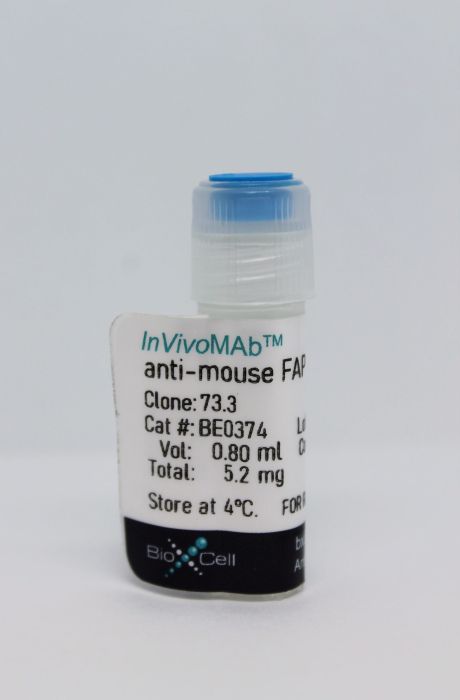InVivoMAb anti-mouse FAP
Product Details
The 73.3 monoclonal antibody reacts with mouse fibroblast activation protein (FAP), a cell-surface serine protease that acts on various hormones and extracellular matrix components. FAP is expressed during embryonic development, in tissues of healing wounds, and in chronic inflammatory and fibrotic conditions. FAP expression is highly upregulated in cancer-associated fibroblasts in epithelial tumors. Cancer-associated fibroblasts overexpression of FAP promotes tumor development and metastasis by influencing extracellular matrix remodeling, intracellular signaling, angiogenesis, epithelial-to-mesenchymal transition, and immunosuppression. The scFv of the 73.3 antibody has been used to construct 73.3-FAP-CAR T cells specific for FAP. Adoptively transferred 73.3-FAP-CAR T cells have been shown to inhibit the growth of multiple syngeneic mouse tumor models.Specifications
| Isotype | Mouse IgG1, κ |
|---|---|
| Recommended Isotype Control(s) | InVivoMAb mouse IgG1 isotype control, unknown specificity |
| Recommended Dilution Buffer | InVivoPure pH 7.0 Dilution Buffer |
| Immunogen | Mouse FAP-expressing 3T3 cells |
| Reported Applications |
Chimeric antigen receptor construction Flow cytometry |
| Formulation |
PBS, pH 7.0 Contains no stabilizers or preservatives |
| Endotoxin |
<2EU/mg (<0.002EU/μg) Determined by LAL gel clotting assay |
| Sterility | 0.2 μM filtered |
| Production | Purified from tissue culture supernatant in an animal free facility |
| Purification | Protein G |
| Molecular Weight | 150 kDa |
| Storage | The antibody solution should be stored at the stock concentration at 4°C. Do not freeze. |
Recommended Products
Chimeric antigen receptor construction
Targeting fibroblast activation protein in tumor stroma with chimeric antigen receptor T cells can inhibit tumor growth and augment host immunity without severe toxicity PubMed
The majority of chimeric antigen receptor (CAR) T-cell research has focused on attacking cancer cells. Here, we show that targeting the tumor-promoting, nontransformed stromal cells using CAR T cells may offer several advantages. We developed a retroviral CAR construct specific for the mouse fibroblast activation protein (FAP), comprising a single-chain Fv FAP [monoclonal antibody (mAb) 73.3] with the CD8alpha hinge and transmembrane regions, and the human CD3zeta and 4-1BB activation domains. The transduced muFAP-CAR mouse T cells secreted IFN-gamma and killed FAP-expressing 3T3 target cells specifically. Adoptively transferred 73.3-FAP-CAR mouse T cells selectively reduced FAP(hi) stromal cells and inhibited the growth of multiple types of subcutaneously transplanted tumors in wild-type, but not FAP-null immune-competent syngeneic mice. The antitumor effects could be augmented by multiple injections of the CAR T cells, by using CAR T cells with a deficiency in diacylglycerol kinase, or by combination with a vaccine. A major mechanism of action of the muFAP-CAR T cells was the augmentation of the endogenous CD8(+) T-cell antitumor responses. Off-tumor toxicity in our models was minimal following muFAP-CAR T-cell therapy. In summary, inhibiting tumor growth by targeting tumor stroma with adoptively transferred CAR T cells directed to FAP can be safe and effective, suggesting that further clinical development of anti-human FAP-CAR is warranted.
Flow Cytometry
FAP Delineates Heterogeneous and Functionally Divergent Stromal Cells in Immune-Excluded Breast Tumors PubMed
Cancer-associated fibroblasts (CAFs) are generally associated with poor clinical outcome. CAFs support tumor growth in a variety of ways and can suppress antitumor immunity and response to immunotherapy. However, a precise understanding of CAF contributions to tumor growth and therapeutic response is lacking. Discrepancies in this field of study may stem from heterogeneity in the composition and function of fibroblasts in the tumor microenvironment. Furthermore, it remains unclear whether CAFs directly interact with and suppress T cells. Here, mouse and human breast tumors were used to examine stromal cells expressing fibroblast activation protein (FAP), a surface marker for CAFs. Two discrete populations of FAP(+) mesenchymal cells were identified on the basis of podoplanin (PDPN) expression: a FAP(+)PDPN(+) population of CAFs and a FAP(+)PDPN(-) population of cancer-associated pericytes (CAPs). Although both subsets expressed extracellular matrix molecules, the CAF transcriptome was enriched in genes associated with TGFbeta signaling and fibrosis compared with CAPs. In addition, CAFs were enriched at the outer edge of the tumor, in close contact with T cells, whereas CAPs were localized around vessels. Finally, FAP(+)PDPN(+) CAFs suppressed the proliferation of T cells in a nitric oxide-dependent manner, whereas FAP(+)PDPN(-) pericytes were not immunosuppressive. Collectively, these findings demonstrate that breast tumors contain multiple populations of FAP-expressing stromal cells of dichotomous function, phenotype, and location.
Chimeric antigen receptor construction, Flow Cytometry
Loss of cells expressing fibroblast activation protein has variable effects in models of TGF-beta and chronic bleomycin-induced fibrosis PubMed
Fibroblast activation protein (FAP), a cell surface serine protease, is upregulated on a subset of activated fibroblasts (often distinct from alpha-smooth muscle actin-expressing myofibroblasts) associated with matrix remodeling, including fibroblasts in idiopathic pulmonary fibrosis (Acharya PS, Zukas A, Chandan V, Katzenstein AL, Pure E. Hum Pathol 37: 352-360, 2006.). As FAP(+) fibroblasts could be pivotal in either breakdown and/or production of collagen and other matrix components, the goal of this study was to define the role of FAP(+) cells in pulmonary fibrosis in two established, but different, mouse models of chronic lung fibrosis: repetitive doses of intratracheal bleomycin and a single dose of an adenoviral vector encoding constitutively active TGF-beta1 (Ad-TGFbeta). To determine their role in fibrotic remodeling, FAP-expressing cells were depleted by injection of T cells expressing a chimeric antigen receptor specific for murine FAP in mice with established fibrosis. The contribution of FAP to the function of FAP-expressing cells was assessed in FAP knockout mice. Using histological analyses, quantification of soluble collagen content, and flow cytometry, we found that loss of FAP(+) cells exacerbated fibrosis in the bleomycin model, a phenotype largely recapitulated by the genetic deletion of FAP, indicating that FAP plays a role in this model. In contrast, depletion of FAP(+) cells or genetic deletion of FAP had little effect in the Ad-TGFbeta model highlighting the potential for distinct mechanisms driving fibrosis depending on the initiating insult. The role of FAP in human lung fibrosis will need to be well understood to guide the use of FAP-targeted therapeutics that are being developed.


